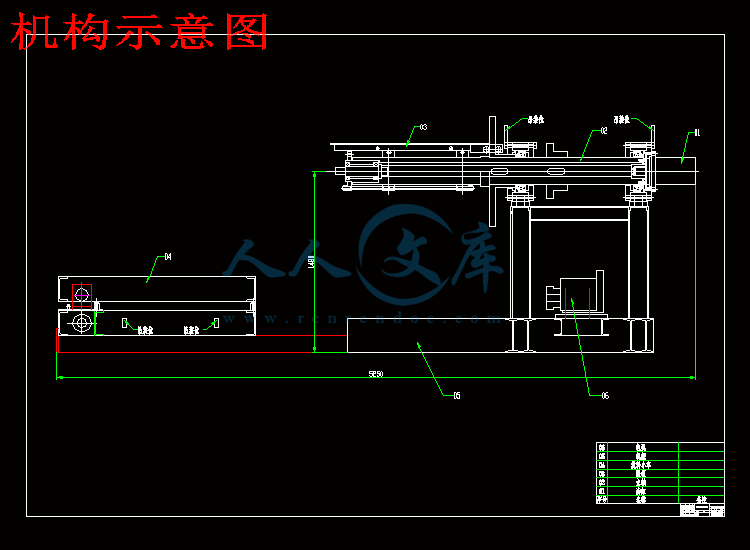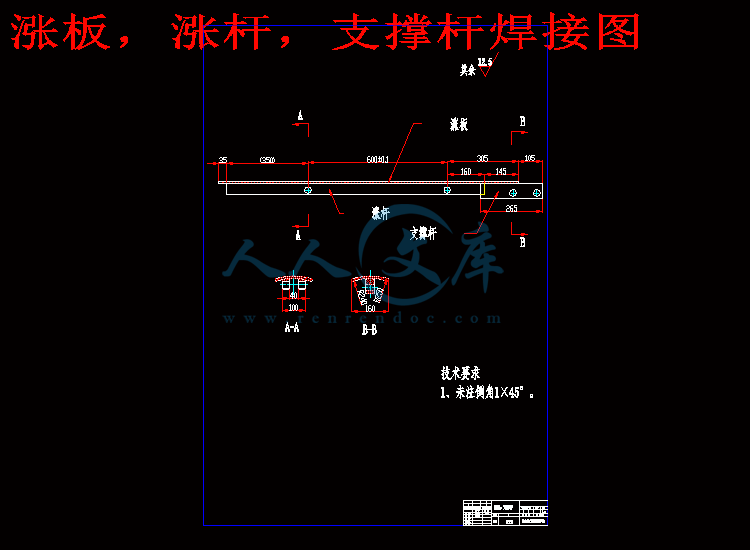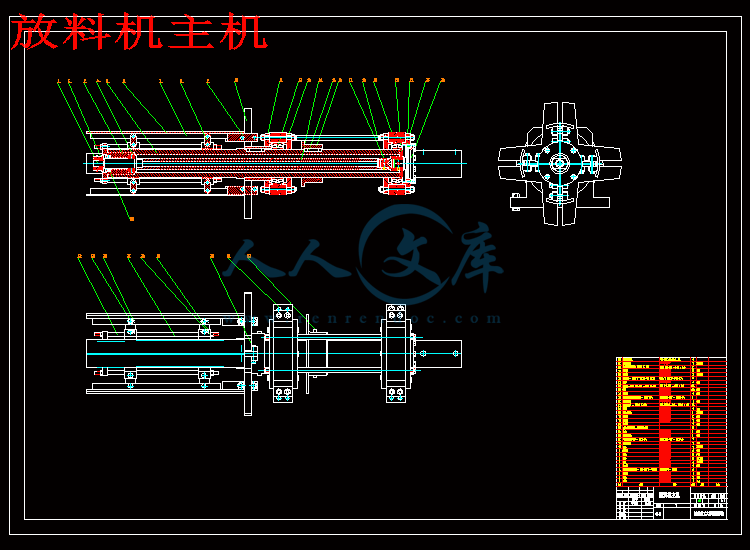【温馨提示】 购买原稿文件请充值后自助下载。
[全部文件] 那张截图中的文件为本资料所有内容,下载后即可获得。
预览截图请勿抄袭,原稿文件完整清晰,无水印,可编辑。
有疑问可以咨询QQ:414951605或1304139763
目录
前言………………………………………………………………3
绪论………………………………………………………………6
摘要………………………………………………………………8
一、放料机主机设计……………………………………………10
1放料机的总体设计………………………………………..10
1.1放料机的设计步骤……………………………………………....10
1.1.1调查研究…………………………………………………….11
1.1.2方案拟订…………………………………………………….12
1.1.3工作图设计………………………………………………….12
1.1.4样机试制和鉴定…………………………………………….12
1.2放料机机组概论…………………………………………12
1.2.1放料机机组概述…………………………………………12
1.2.2机组技术参数………………………………………12
1.2.3放料机机组设备组成……………………………………12
1.2.4工艺流程…………………………………………………13
1.2.5机组的生产操作过程……………………………………13
1.2.6放料机设计基本参数……………………………………14
1.2.7设备用途………………………………………………14
1.2.8放料机的传动系统与电气系统………………………15
1.3放料机的总体结构…………………………………………15
2 放料机主体参数的设计 ………………………………16
2.1空心主轴的设计计算………………………………………………………16
2.1.1空心主轴的直径计算…………………………………………………16
2.1.2空心主轴的校核计算…………………………………………………20
2.2 芯轴的设计计算…………………………………………………………..24
2.3 轴承选用及寿命计算……………………………………………………..25
2.4电机选用……………………………………………………………………26
3 放料主机其他配件的设计………………………………………………………27
3.1 链轮…………………………………………………………………………27
3.2滑动套……………………………………………………………………….28
3.3 涨板…………………………………………………………………………29
4 放料主机的机架…………………………………………………………………32
二、 放料小车…………………………………………………………………………34
1. 小车的行程计算…………………………………………………………………34
2. 小车上下支架管计算……………………………………………………………34
3. 小车的内外转臂的计算…………………………………………………………38
4. 油缸支撑杆………………………………………………………………………40
三、 液压系统……………………………………………………………………….41
1. 液压系统的设计要求……………………………………………………………42
2. 液压系统方案设计………………………………………………………………42
3. 液压系统原理图设计……………………………………………………………43
结束语………………………………………………………………………………….44
致谢……………………………………………………………………………………45
参考文献………………………………………………………………………………46
中文翻译………………………………………………………………………………46
附:英文资料…………………………………………………………………………49
前 言
光阴似箭,岁月如梭。四年的大学生活即将接近尾声,进行了为期近两个月的毕业设计。大家都知道毕业设计是对大学四年来我们所学到的基础知识和专业知识的一次系统性的总结与综合运用,同时也是培养我们分析问题和解决问题能力的良好的机会,而且毕业设计也是大学教学的最后一个重要环节。因此,认真踏实地做好这次毕业设计不仅意味着我们能否顺利毕业,而且对今后我们走上工作岗位后能否很出色的做好自己的工作也有十分重要意义。另外,毕业设计还可以培养我们独立思考,开发思维和协调工作的能力,这对今后踏入社会以后能否尽快地适应社会也有很大的帮助。
通过这一环节的训练,提高了以下能力:
1、综合运用所学知识和技能,独立分析和解决实际问题的能力;
2、综合运用基本技能,包括绘图、计算机应用、翻译、查阅及阅读文献等的能力;
3、调动实验研究的积极性,技术经济分析和组织协作工作的能力,学习撰写科技论文和技术报告,正确运用国家标准和技术语言阐述理论和技术问题的能力;
4、学会收集加工各种信息的能力,以及获取新知识的能力;
5、培养创新意识和严肃认真的科学作风。、
6、 培养我们综合运用和巩固扩展所学知识,提高理论联系实际的能力;
7、 培养我们收集、阅读、分析和运用各种资料,手册等科技文献的能力;
8、 培养学生调查研究、正确熟练运用国家标准、规范、手册等工具书的能力;
9、 使我们更加熟练的运用AUTOCAD、Word 等计算机办公软件,提高计算机辅助设计的能力;
10、训练和提高机械设计的基本理论和技能;
11, 培养我们的团队合作意识。
本次毕业设计的课题是5吨放料机的设计。5吨放料机是用来配套成型主机使用的,具有结构轻巧,使用方便,自动化程度高,与各种形式的成型主机,成型剪,电脑控制柜一起组成一条完整的自动化生产线。为了更好的完成本次毕业设计,从三月底开始,就不间断的结合自己的毕业设计进行了毕业实习。根据所选的课题,有重点的选择了实习工厂——厦门正黎明冶金机械有限公司,在工厂里我们重点了解了5吨放料机的基本结构和基本工作原理,以及其重要部件——放料小车的工作原理。从而对放料机有了一个更直接、更感性的认识,对此次毕业设计有很大的帮助。
此次设计的主要内容有:问题的提出、总体方案的构思、可行性设计、结构设计以及对未知问题的探索和解决方案的初步设计,装配图、零件图等一系列图纸的设计与绘制,最后包括毕业设计说明书的完成。
这次毕业设计是在焦锋老师的带领和指导下完成的。在做毕业设计的期间,自己遇到了诸多的问题,很多时候都是向老师请教,这样必然会给老师带来很多麻烦,势必会影响老师的工作,但是老师还是抽出时间来给我们辅导,一步步指导毕业设计有序如期的进行下去。在毕业设计的整个过程当中,老师都给我们作了明确的计划,有安排地去完成,而不至于在设计过程中没有目标,如果那样会使设计很盲目。设计每进行一步,焦锋老师都要认真的检查,耐心细致的指出设计中出现的错误和不恰当的地方,并指导我们修改和完善。每次辅导对学生提出的问题都认真的解答。陈老师为我们的设计付出了巨大的心血,在此,我向焦锋老师表示由衷的谢意!
本次毕业设计的题目是5吨放料机的设计,设计放料机应该满足的基本要求有以下几点:
(1)适用范围。放料机的适用范围是指配合成型主机的类型,以及所放料的彩板的重量、类型、材料和尺寸范围等。
(2)辅机设备运转控制精度。
(3)生产率。放料机所配合使用的成型主机的生产率通常指单位时间内成型主机所能成型的彩板数量。
(4)自动化程度。
(5)操作安全方便和工作可靠。
(6)效率,使用期限和成本等等。设计时还应该注意使放料机体积小,重量轻,占地面积小,外形美观以及注意防止环境污染,如减少噪音,防止漏油等等。
对于上述所提到的各项技术—经济指标,在设计放料机的时候应该综合考虑。因为我做的主要是5吨放料机机械部分的设计,所以还要兼顾其他方面,这是个挑战又是个机会,锻炼了自己在设计时要综合考虑问题,认真的分析机构工作原理的能力。具体将在下面的章节中进行详细的叙述。
绪 论
机械工业的生产水平是一个国家现代化建设水平的主要标志之一。这是因为工业、农业、国防和科学技术的现代化程度,都会通过机械工业的发展程度反映出来。人们之所以要广泛使用机器,是由于机器既能承担人力所不能或不便进行的工作,又能较人工生产改进产品的质量,特别是能够大大提高劳动生产率和改善劳动条件。机械工业肩负着为国民经济各个部门提供技术装备和促进技术改造的重要任务,在现代化建设的进程中起着主导和决定性的作用。所以通过大量设计制造和广泛使用各种各样先进的机器,就能大大加强和促进国民经济发展的力度,加速我国的社会主义现代化建设。
制造业是一个国家或地区经济发展的重要支柱,其发展水平标志着该国家或地区的经济实力、科技水平、生活水准和国防实力。成型主机是机械制造业中的冷弯成型设备。随着社会需求和科学技术的发展,对成型主机设计要求越来越高,相应地也对辅机设备—放料机提出了更高的要求。尤其是微电脑控制的出现,使主机向自动化控制、运行平稳、高精度的方向发展。因此,对辅机的精度和自动化控制等各方面的要求也就越来越高。
“工欲善其事,必先利其器”。为了得到更高的产品质量(包括产品的尺寸精度、板面状况、板形、强度、耐疲劳强度等各项技术指标)以及数量上的要求,满足生产、生活和科学技术发展的需要,进而适应社会的发展和生产力水平的提高,加速社会主义现代化建设,我们必须不断的对国民经济发展的重要支柱进行改造和提高,才能够为其它的行业的发展提供更多的基础设施和良好的发展环境、条件。这就要求我们机械制造专业的工人及科研人员要对机械设备进行适应生产力发展的改造,创新以及发明。我们这些即将大学毕业的机械制造专业的学生,要进行对本专业所学习的知识进行综合的运用和掌握,为此我们要进行毕业设计,要自己动手进行设计,为社会主义现代化建设的发展贡献力量,也要从此迈出展现自己价值的第一步。
本次设计是本公司生产实际的需要,设计配合各种成型主机(角驰760/950,、yx28-410-820成型机,Q900A型机,yx66-470型机等)使用的5吨放料机,其型号为5T x 1250mm,它与成型主机,成型剪,电脑控制柜一起组成一条独立完整的自动化生产线。本次设计力图使设备运转更加的平稳,节约劳动力,保证精度的要求,提高生产的效率。但由于本人的水平有限,结合生产实际应用设备的能力有限,故没有能够做到很详细的设计,而且还有许多地方有待改进,望导师给以指导和批评。
摘要
本次放料机的设计是5吨 x 1250mm放料机,是用来配套成型主机使用的,它与各种形式的成型主机,成型剪,电脑控制柜一起组成一条完整的自动化生产线。
放料机整机主要有三大部分,即放料机主机,放料小车,整机液压和电气系统。三者互相配合,缺一不可,共同组成统一的整体,完成整体特定的功能。
第一部分介绍放料机主机设计,从放料机主体结构设计,放料机主要参数的确定,到放料机传动系统,以及放料机其他主要配件的设计。
第二部分是放料小车的设计,具体是确定小车的行程,小车的内外转臂,小车各支撑杆,使其完成一个钢卷放上小车并送上放料主机的功能。
第三部分是液压系统,包括放料机主机芯轴推动的油压系统以及放料小车撑杆的液压系统。
. 关键词:放料机、放料小车、成型主机
Abstract
It was five ton X 1250mm discharge machine,be intended to mating moulding mainframe used,it alongside with multiform moulding mainframe,moulding cut,computercontrolled tank compose item rounded automatic production line that that of these degree discharge machine DESign.
The discharge machine complete machine mostly has three in a great measure,namely discharge machine mainframe,discharge bogie,complete machine hydraulic pressure and electrical system. three soprano interwork, hard up one incoagulable,together compose unify whole,finish whole specific function with into.
The DESign of the the first part introduce discharge machine mainframe DESign,from discharge machine major structure DESign,discharge machine major parameter forsooth book, till discharge machine transmission agent,as well as discharge machine rest mostly appurtenance.
It was discharge bogie 'DESign,concretion yes ascertain bogie' journey,bogie 'inside and outside tumbler,bogie each buttress,lead thereof finish one coil of strip radiating matter upper bogie combine deliver upper discharge mainframe' function with to up that second part.
It was hydraulics,include discharge machine mainframe pivot impel oil hydraulic system and discharge bogie stay bar 'hydraulics as well to that third part.
Keyword:discharge machine, discharge bogie, moulding mainframe







 川公网安备: 51019002004831号
川公网安备: 51019002004831号